Realworld Mathematics
Montessori Elementary Mathematics Curriculum
Elementary Mathematics
On one level, the purpose and value of math seems obvious. Students need math to function as adults: to pay bills, make change, negotiate salaries, and so on. Virtually every career today requires some mathematical skill, and specialized careers usually involve advanced mathematical knowledge. But the importance of math goes much deeper than these obvious benefits. Mathematical training is important because it develops a student’s ability to think logically and precisely. A proper math education gives an individual the capacity to approach all areas of one’s thought and life with rigor and discipline. When Abraham Lincoln wanted to sharpen his general reasoning skills at age 40, he did so by working through Euclid’s Elements. A successful thinker must be able to structure and organize ideas, and bring order to one’s mind. Mastery of math develops this mental capacity in students.
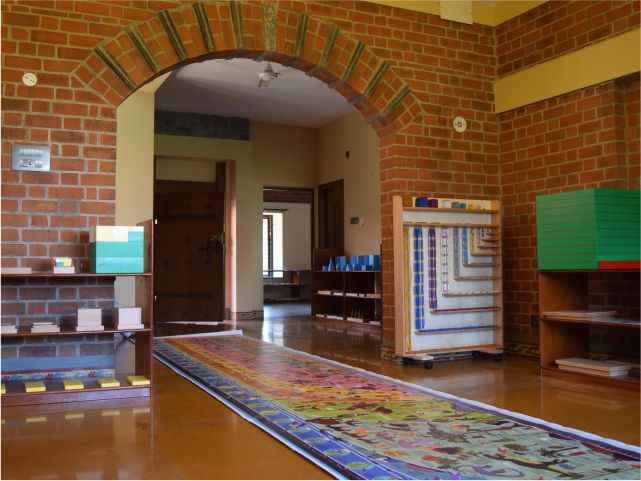
“At her old school, my daughter worked really hard in math, and it just didn’t work. She told her teacher that math is now one of her favourite subjects and you have no idea what that means: this came as a total shock to me and her dad, because she used to cry doing math. It’s a total turn around from what it was before. Two of her least-favourite subjects, math and science, are now her favourites!””
by Vruksha ParentElementary Math: What Your Child Study?
A systematic progression from materials to pictorial representations to abstractions and formulae
Over the six years of elementary, our program enables children to achieve facts
and procedure mastery, as well as a deep, conceptual understanding of math concepts, which enables
them to be ready for advanced math in junior and high school. Most importantly, many of our students
discover the joy of thinking mathematically and are eager to tackle challenging problems, rather
than view math as something that is “not for me
In Lower Elementary, children typically
work on new concepts with a wide range of scientifically designed Montessori materials. Over
time, by Upper Elementary, children begin to “let go of the materials” and move into abstract
understanding of how numbers work. At its heart, our elementary mathematics program is about
flexibility and fluency with numbers. We want children to visualize patterns, develop number
sense, think critically and logically, and propose solution paths that others can see, discuss
and critique. It is these core cognitive skills that will aid children in many areas of
their adult lives.
Basic numeracy
This is a short review for our Montessori Primary students, who have learned these skills by Kindergarten. Students new to Montessori will use advanced primary materials from the Bead Cabinet to the Golden Bead Materials to learn counting, skip counting, place value (the decimal system), and the basic four operations of arithmetic. With t his exposure to the primary materials, students joining us in 1st or 2nd grade will also acquire the skills of using concrete materials to set up and solve mathematical problems a skill they will use throughout their lower elementary years.
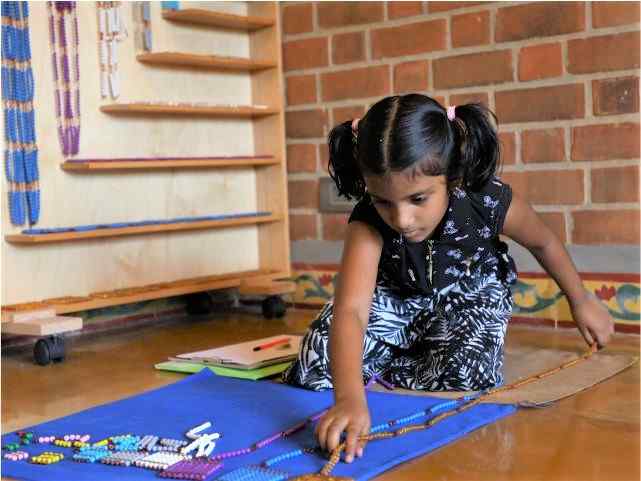
The four operations of arithmetic into the millions
By 3rd grade, our students will have mastered the four operations into the millions including long multiplication with multi-digit multipliers, and long division with three-digit divisors. We also teach them the basic laws of arithmetic (e.g., associative, commutative, and distributive properties) as well as multiples and factors. Importantly, our students learn to work with large numbers, using materials and paper and pencil, instead of transitioning to calculators prematurely.
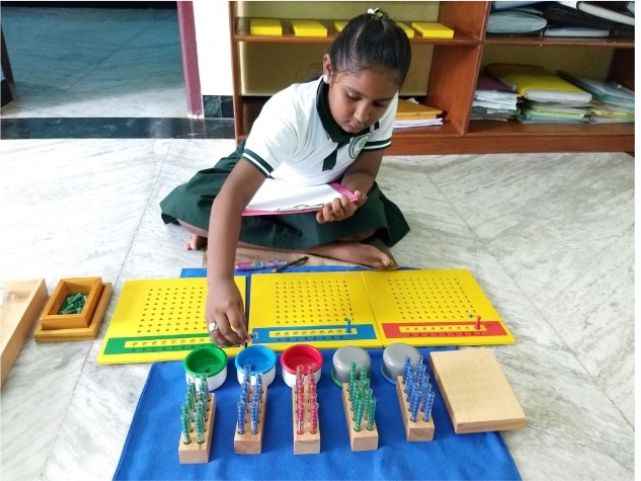
Fractions and Decimals
Starting in Lower Elementary students gain a solid understanding of fractions and decimals they learn what each is by using Montessori materials in the early years; then, they learn to work arithmetical problems with decimals and fractions abstractly, with paper and pencil and as part of applied work problems in Upper Elementary.
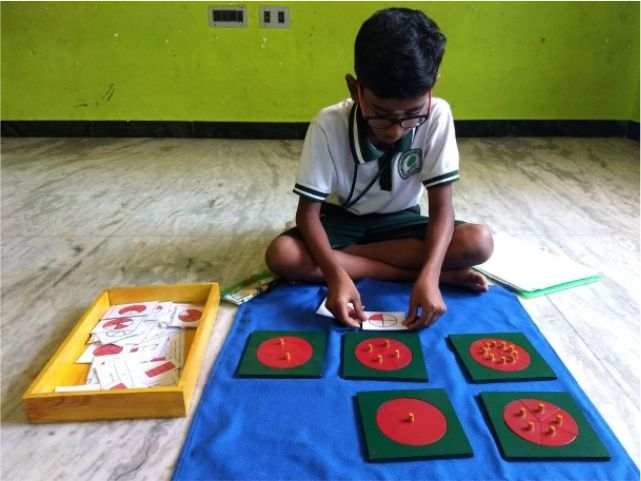
A pictorial link from concrete to abstract math
In addition to continuing to use Montessori lessons and materials, in Upper Elementary, we introduce the bar diagramming method of the Singapore Math program. This is particularly helpful when working with ambiguous, multi-step word problems. Singapore Math helps children visualize problems by turning abstract words into easy-to-understand pictorial models. The student can then determine which mathematical strategy to employ to deduce an answer, a skill that will make their later algebra work much easier to master.
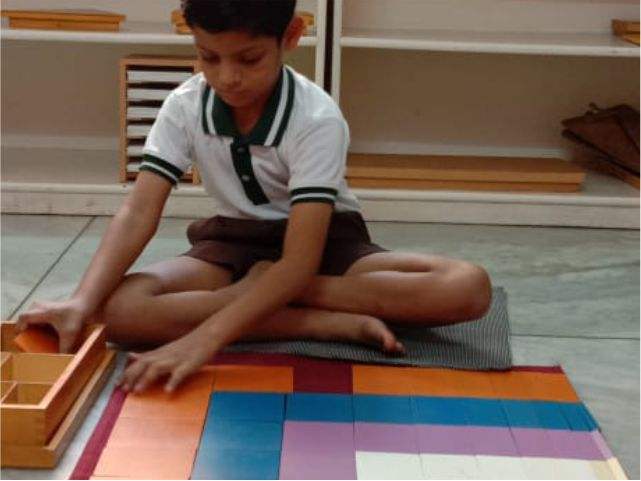
Geometry
A rich geometry curriculum is a unique strength of Montessori Elementary mathematics. Building upon their introduction to geometry in the Sensorial area in preschool, we introduce our students to congruency, similarity, and equivalence. Our students learn to draw, define, and describe lines, polygons, angles, circles, and geometric solids. They learn how to measure length and area—and apply those skills to the geometric shapes and solids. They acquire basic skills, such as using a ruler and a compass, which are prerequisites for the later study of geometry.
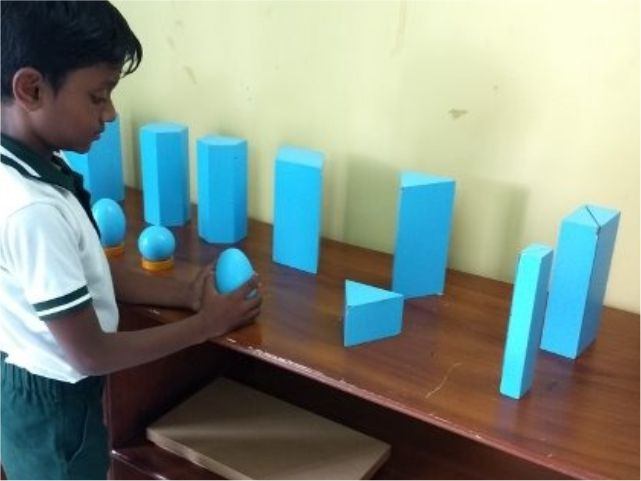
Measurements
Children are taught both customary (Imperial) and metric systems of measurement. They apply their skills by solving many word problems, and are taught to convert between these systems. In 4th grade, they may start with simple problems, such as “Jacob is making a label for his binder. His binder is 29 cm long. He wants to leave 8cm 4mm on each side of the label. How long should the label be?” By 6th grade, they may be converting between systems: “A competitive college runner ran a 5 km race in 15 min, 23 seconds. What was her pace in miles per hour?”
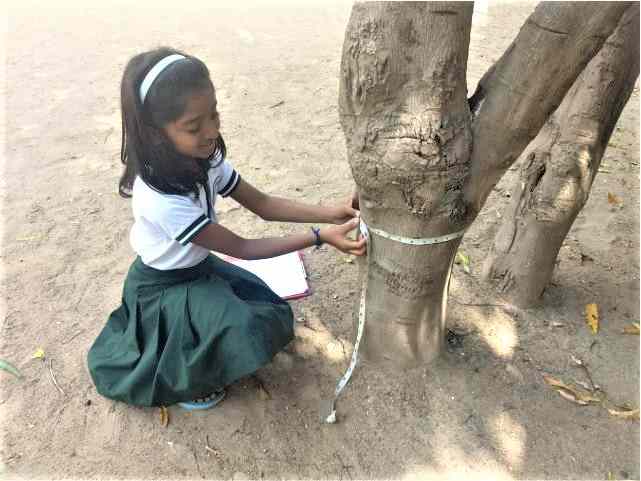
Math facts practice for computational fluency
The facts practice component helps students build computational speed and retain basic facts such as mental multiplication (9 x 12 = 108), fraction-percentage equivalents (1/8 = 12.5%) and measurement conversions (1 mi = 1760 yds). When someone says, “Baa, Baa, Black Sheep, Have you any _______”, the word wool immediately jumps to mind. No effort is required. The goal of our facts practice program is to enable our students to similarly access a range of math facts without effort so that they can instead use that effort towards analyzing a complex problem. Students use a variety of methods to practice facts ranging from quizzing themselves and each other with flash cards, using iPad math facts games, and taking timed facts practice quizzes that encourage them to improve their scores over time. Students are motivated to compete against themselves in facts practice. They chart their performance, set goals, and see if they can improve on their previous day’s score, without focusing on their peers’ scores or any normed grades. This enables each student to focus on achieving one’s personal best.
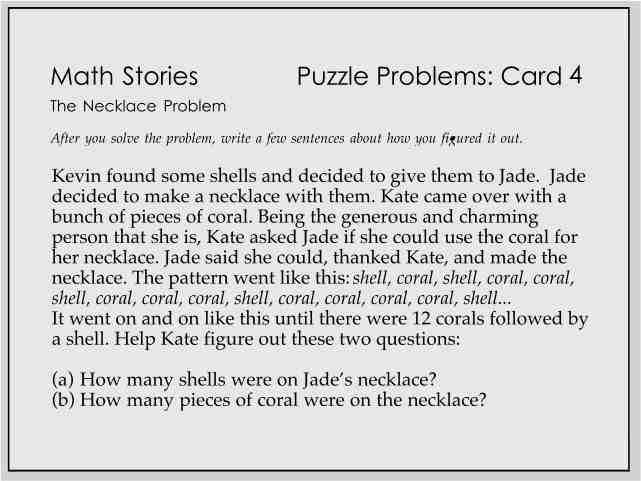
For Your Deeper Understanding
How Montessori Math Moves From Concretes to Abstractions: The Example of Long Multiplication
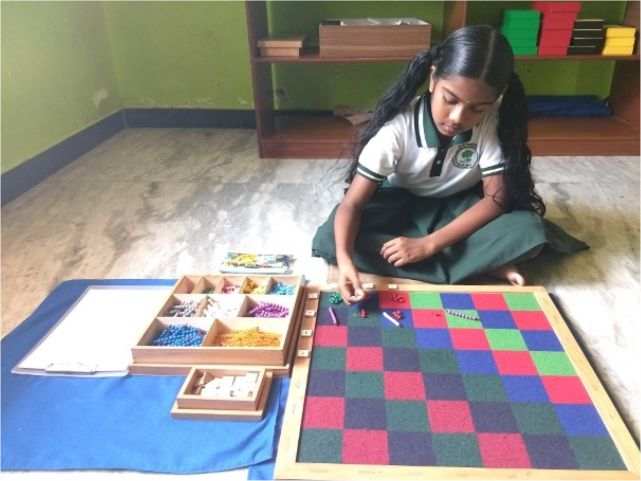 Children first encounter multiplication in our Montessori Primary program.
They learn that it is a special form of addition that is, putting the same quantity
together multiple times. They use the Coloured Bead Bars for this: these bars are made
of different coloured beads according to the numerical value of the bar. The 10-bead
bars consist of 10 golden beads strung together; the 9-bead bars have 9 dark blue beads;
the 8-bead bars are brown, and so on. To do a multiplication problem, let’s say 7 x 4,
the student would take four of the white 7 bead bars, and count all the beads to get the
result, 28. He would then convert the result into two golden ten bars, and a brown eight
bar to symbolize 28.
Children first encounter multiplication in our Montessori Primary program.
They learn that it is a special form of addition that is, putting the same quantity
together multiple times. They use the Coloured Bead Bars for this: these bars are made
of different coloured beads according to the numerical value of the bar. The 10-bead
bars consist of 10 golden beads strung together; the 9-bead bars have 9 dark blue beads;
the 8-bead bars are brown, and so on. To do a multiplication problem, let’s say 7 x 4,
the student would take four of the white 7 bead bars, and count all the beads to get the
result, 28. He would then convert the result into two golden ten bars, and a brown eight
bar to symbolize 28.
Gradually, in late Primary and into Elementary, students are
introduced to more advanced multiplication problems and strategies to solve them more quickly.
They also move from very concrete presentations to more abstract ones, and finally graduate
to solving long multiplication problems with pencil and paper alone. Throughout, our
teachers have a wide variety of materials at their disposal—materials which build upon
each other, and are integrated by a consistent, systematic use of colours (which helps
as a memory aid).
Students learn about the decimal system (place value) with the Golden Beads materials—units of individual beads, bars of ten beads, squares of 100 beads and cubes of 1,000 beads. Our elementary students also get the unique experience of working with the Wooden Hierarchical Material, which demonstrates, in concrete terms, the proportionate difference in size between a single unit and a million!
They learn skip-counting with the Bead Chains that repeat the colours of the smaller bead bars: for example, a short 5-chain has five light blue 5 bead bars hooked together, and will make a square of 25 when folded together.
They use the Multiplication Finger Board to understand and begin to memorize the times table. On this board, children set up and develop their own multiplication tables, which they often bind into little booklets and use to memorize their multiplication facts.
They are introduced to multiplying larger numbers using the Golden Beads—exchanging units of beads to tens for carrying, and tens to hundreds. (Of course, they have first learned to add, and are now simply adding the same quantity several times.)
They learn to multiply more abstractly with the Stamp Game, where units, tens, hundreds and thousands are represented by color-coded number squares, instead of beads. The photo show 2,321 x 3 set up with the Stamp Game.
They work with the Small Bead Frame, and then the Large Bead Frame, the Montessori version of an abacus, where place value is indicated by bead position, and where students need to apply math facts to move the right number of units, tens, hundreds and so on.
They are introduced to long multiplication (where the multiplier has two or more digits) with Montessori’s unique Multiplication Checkerboard material. Here the place value is indicated by the bead’s position on the board, and partial products are made visible. After setting the problem up with numerical tiles placed around the checkerboard, the child places the designated number of coloured bead bars in the correct spots. For our example, he would take three light blue 5-bead bars, and place them in the unit square; three green 2-bead bars in the tens square, three yellow 4-bead bars in the hundreds square, and three lavender 6-bead bars in the thousands square.
Later on, they multiply decimals using the Decimal Checkerboard, applying the same ideas and principles they learned with the Multiplication Checkerboard for integers to decimals.
Throughout, we introduce our students to increasingly more complex multiplication problems and ever larger numbers; we also guide them to apply math facts to work faster:
More complex problems: The multiplicand will grow to two digits, then three. The materials help to visualize what that means. For example, the differently coloured squares in the rows of the checkerboard indicate the decimal places for the results.
Larger numbers: Our students are fascinated by and eagerly do problems into the millions and beyond. With the Large Bead Frame, students can do math into the millions—and the Checkerboard can generate results up into the billion range. Not only do these large quantities challenge our students’ skills, they are inherently motivating to youngsters who are enthusiastic about digging into big work.
Using memorized math facts: Instead of counting out multiple bead bars, then exchanging with the checkerboard, we guide our students to do the math facts in their heads. For instance, to solve 6 x 8, instead of putting eight 6-bead bars on the checkerboard, they arrive at 48 in their heads, and then place an 8-bead bar in the units, and a 4-bead bar in the tens. This shows students how knowing the facts makes them more efficient, and provides motivation to learn the facts. It’s also necessary to solve problems on the Bead Frames—an example of how mastery at one stage in the sequence opens the door to the next stage.
Writing the problem on graph paper: We teach students how to write down the problems on paper using the correct place values, and how to document partial products. This facilitates cross-checking and identifying the source of errors.
How it Differs?
How Montessori Elementary Math Compares to Regular Board School Standards
Montessori math is more in-depth, and children can progress through the math curriculum as quickly as their interest and ability allows. Students are never held back, waiting for the whole class to catch up! They start learning concepts such as place value, multiplication, and fractions as early as Primary and spiral back to these concepts with increasing abstraction and sophistication throughout the elementary years. Thus, they don’t just study math for tests, only to soon forget, but internalize ideas so well, they retain them for life, and apply them to new settings.
Here are some examples of how Montessori Elementary Math compares:
| Area | Points of Comparison |
|---|---|
Arithmetic |
|
Fractions |
Deeper exploration with hands-on materials, earlier. Children in Montessori go beyond basic equivalence in Lower Elementary: they work on adding, subtracting, multiplying and dividing fractions, and explore their link to decimals. |
Multiples and Factors |
Introduced earlier in Lower Elementary, vs. not until 4th grade and up. Lower Elementary children explore patterns, learn about lowest common multiples, and rules of divisibility. This lays the foundation for advanced work in Upper Elementary—such as squaring and cubing. |
Geometry |
Advanced work in geometry, such as the Pythagorean Theorem and Euclid’s Proof. |
Word Problems |
A pictorial link from concrete to abstract math. Using the bar diagramming method from Singapore Math, in preparation for algebra in junior high. |
Get in Touch with Us
Our Headquarters are in Chennai and Puducherry
27-28, 2nd Cross
Moogambigai Nagar
Reddiarpalayam, Pondy - 605 010
Phone: +91 9994851951
Phone: +91 9361919996
Email: contact@vrukshamontessori.com
24-25, 12th Cross
Ranga Reddy Gardens
Neelankarai, Chennai - 600 041
Phone: +91 9994851951
Phone: +91 9361919996
Email: contact@vrukshamontessori.com
